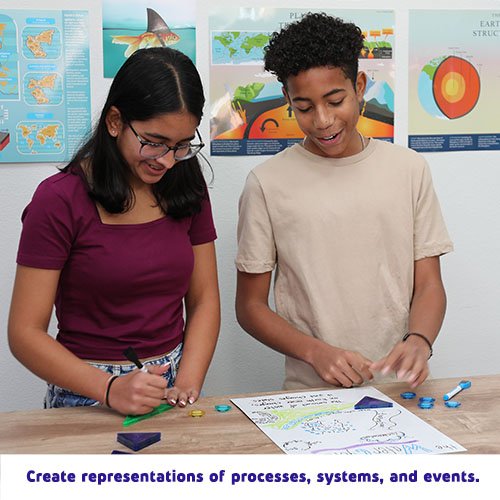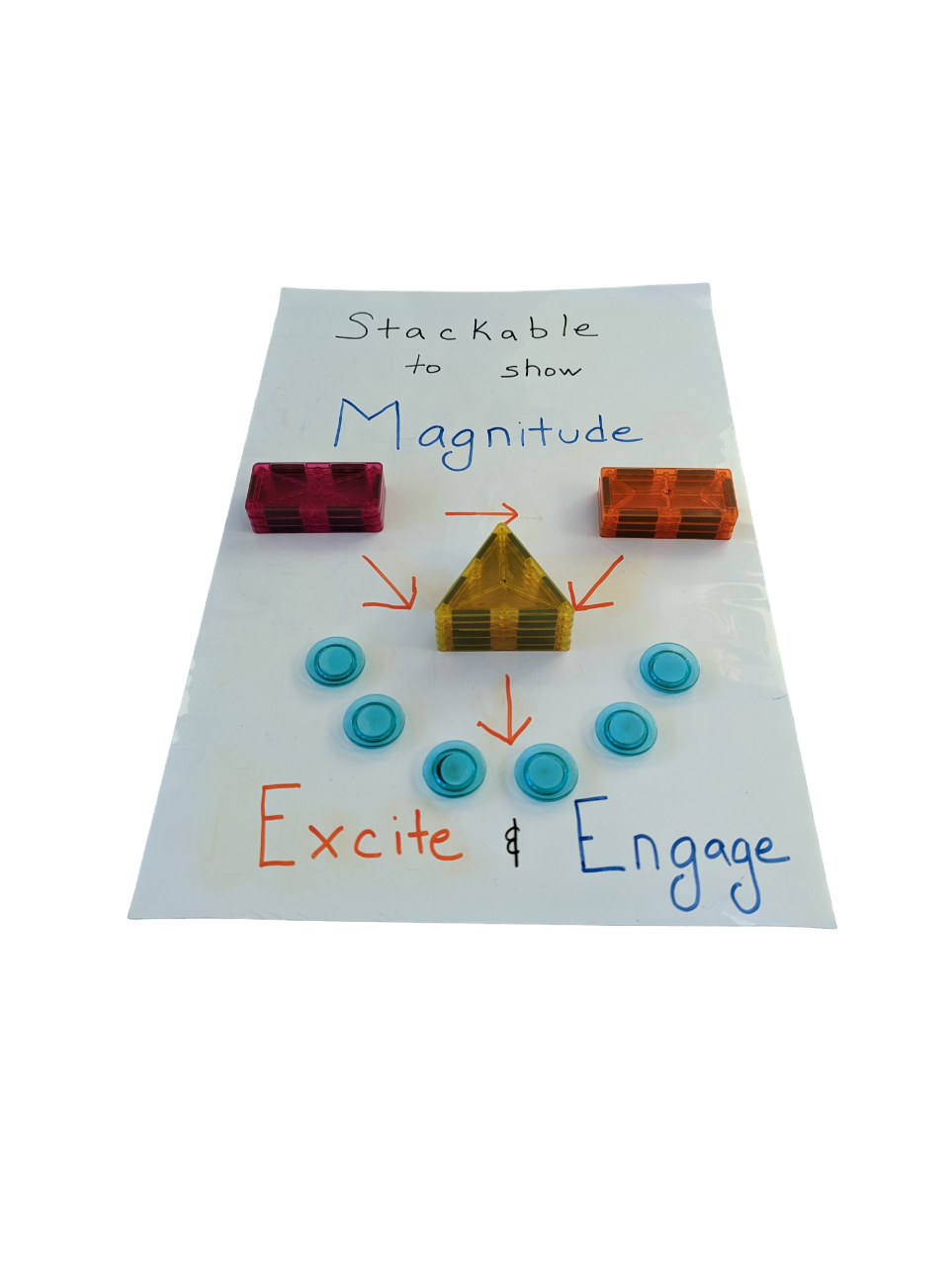Modeling Mat Kit 10-Pack (20 students)
$435.00
Click here to watch it on YouTube
iSprowt’s Modeling Mat kit is designed to help students make thinking visible by creating and revising phenomena-based models.
– Use magnetic tiles to model concepts from molecules to planetary systems.
– Create representations of processes, systems, and events.
– Enable students to easily manipulate, revise and improve their models.
– Magnetic and stackable, dry erase tiles add dimension and visualization to deepen understanding
– Encourage iterative thinking and discussion.
What You'll Get
Each Kit Includes:
- 18 x 12”, paper thin magnetic white boards that roll up for easy, compact storage
- 15 rectangle magnetic and stackable, dry erase tiles
- 15 round magnetic and stackable, dry erase tiles
- 4 specially designed dry eraser pens and erasers that can be used to write on magnets empower proper labeling and modeling to deepen understanding
- Teacher Resources: Teacher Guide ad Teaching Strategies to help make modeling practical and engaging in the classroom.
- Kit is re-usable year after year
Easy for Teachers
- Low mess and easy prep
- All materials are included in each kit – teachers just open and go!
Standards Alignment
iSprowt’s Modeling Mat kit can be used to model physical, life, and earth science including the following NGSS standards.
| MS-PS1-1 | Develop models to describe the atomic composition of simple molecules and extended structures. |
| MS-PS1-4 | Develop a model that predicts and describes changes in particle motion, temperature, and state of a pure substance when thermal energy is added or removed. |
| MS-PS1-5. | Develop and use a model to describe how the total number of atoms does not change in a chemical reaction and thus mass is conserved. |
| MS-PS3-2. | Develop a model to describe that when the arrangement of objects interacting at a distance changes, different amounts of potential energy are stored in the system. |
| MS-PS4-2. | Develop and use a model to describe that waves are reflected, absorbed, or transmitted through various materials. |
| MS-LS1-2. | Develop and use a model to describe the function of a cell as a whole and ways the parts of cells contribute to the function. |
| MS-LS1-7. | Develop a model to describe how food is rearranged through chemical reactions forming new molecules that support growth and/or release energy as this matter moves through an organism. |
| MS-LS2-3. | Develop a model to describe the cycling of matter and flow of energy among living and nonliving parts of an ecosystem. |
| MS-LS3-1. | Develop and use a model to describe why structural changes to genes (mutations) located on chromosomes may affect proteins and may result in harmful, beneficial, or neutral effects to the structure and function of the organism. |
| MS-LS3-2. | Develop and use a model to describe why asexual reproduction results in offspring with identical genetic information and sexual reproduction results in offspring with genetic variation. |
| MS-ESS1-1. | Develop and use a model of the Earth-sun-moon system to describe the cyclic patterns of lunar phases, eclipses of the sun and moon, and seasons. |
| MS-ESS1-2. | Develop and use a model to describe the role of gravity in the motions within galaxies and the solar system. |
| MS-ESS2-1. | Develop a model to describe the cycling of Earth’s materials and the flow of energy that drives this process. |
| MS-ESS2-4. | Develop a model to describe the cycling of water through Earth’s systems driven by energy from the sun and the force of gravity. |
| MS-ESS2-6. | Develop and use a model to describe how unequal heating and rotation of the Earth cause patterns of atmospheric and oceanic circulation that determine regional climates. |
| MS-ETS1-4. | Develop a model to generate data for iterative testing and modification of a proposed object, tool, or process such that an optimal design can be achieved. |
| HS-PS1-1. | Use the periodic table as a model to predict the relative properties of elements based on the patterns of electrons in the outermost energy level of atoms. |
| HS-PS1-4. | Develop a model to illustrate that the release or absorption of energy from a chemical reaction system depends upon the changes in total bond energy. |
| HS-PS1-8. | Develop models to illustrate the changes in the composition of the nucleus of the atom and the energy released during the processes of fission, fusion, and radioactive decay. |
| HS-PS3-2. | Develop and use models to illustrate that energy at the macroscopic scale can be accounted for as a combination of energy associated with the motion of particles (objects) and energy associated with the relative positions of particles (objects). |
| HS-PS3-5. | Develop and use a model of two objects interacting through electric or magnetic fields to illustrate the forces between objects and the changes in energy of the objects due to the interaction. |
| HS-LS1-2. | Develop and use a model to illustrate the hierarchical organization of interacting systems that provide specific functions within multicellular organisms. |
| HS-LS1-4. | Use a model to illustrate the role of cellular division (mitosis) and differentiation in producing and maintaining complex organisms. |
| HS-LS1-5. | Use a model to illustrate how photosynthesis transforms light energy into stored chemical energy. |
| HS-LS1-7. | Use a model to illustrate that cellular respiration is a chemical process whereby the bonds of food molecules and oxygen molecules are broken and the bonds in new compounds are formed, resulting in a net transfer of energy. |
| HS-LS2-5. | Develop a model to illustrate the role of photosynthesis and cellular respiration in the cycling of carbon among the biosphere, atmosphere, hydrosphere, and geosphere. |
| HS-ESS1-1. | Develop a model based on evidence to illustrate the life span of the sun and the role of nuclear fusion in the sun’s core to release energy that eventually reaches Earth in the form of radiation. |
| HS-ESS2-1. | Develop a model to illustrate how Earth’s internal and surface processes operate at different spatial and temporal scalesto form continental and ocean-floor features. |
| HS-ESS2-3. | Develop a model based on evidence of Earth’s interior to describe the cycling of matter by thermal convection. |
| HS-ESS2-4. | Use a model to describe how variations in the flow of energy into and out of Earth’s systems result in changes in climate. |
| HS-ESS2-6. | Develop a quantitative model to describe the cycling of carbon among the hydrosphere, atmosphere, geosphere, and biosphere. |









